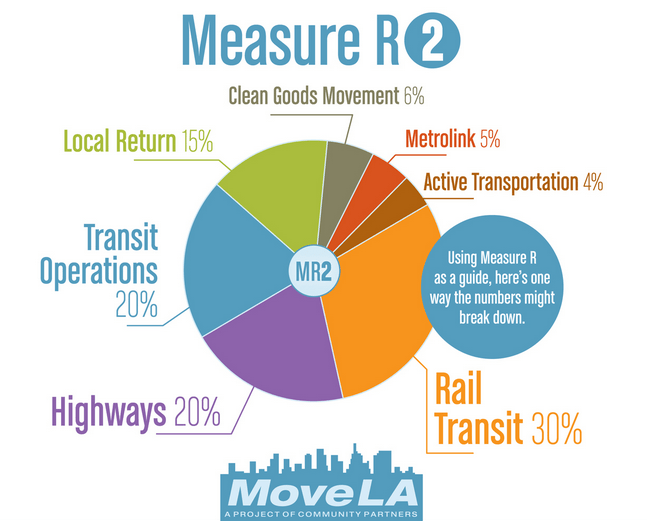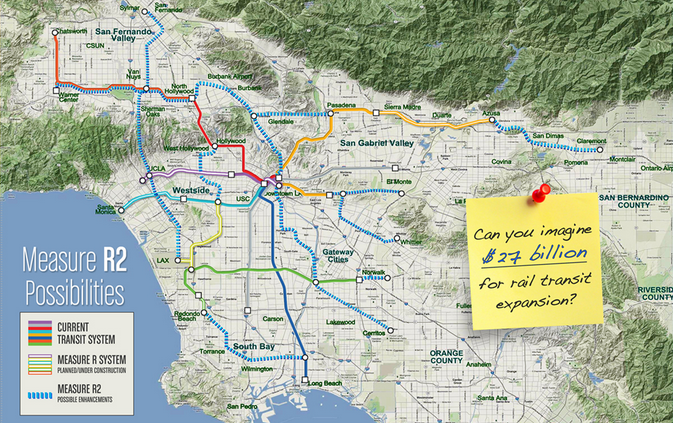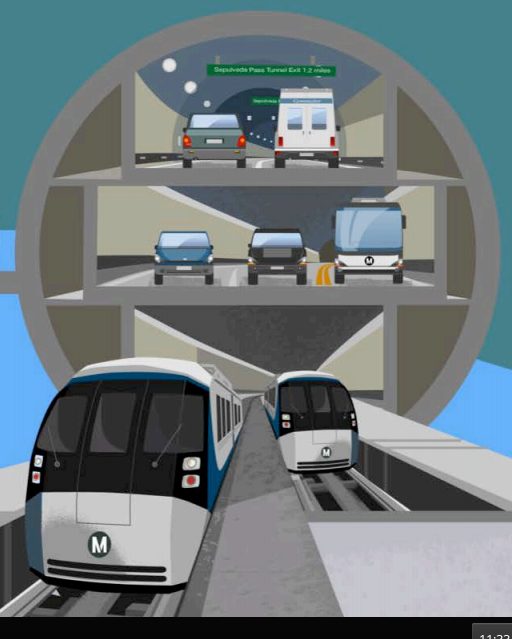Move L.A.’s Measure R2 Draft Proposal, Including Their Rail Fantasy Map
1:33 PM PDT on April 3, 2014

Last week, Move L.A. convened its annual transportation conversation conference under the banner of "Imagining Measure R2." The daylong conference was profiled in the L.A. Times and at the Source. Today SBLA takes a look at Move L.A.'s "strawman" R2 proposal presented that day. It's a draft for purposes of discussion, very likely to change some before it would reaches the ballot in 2016. It looks a lot like Measure R, but there are also a few big differences.
Measure R was a 30-year county-wide half-cent sales tax narrowly approved by L.A. voters in 2008. Measure R funding has been key to Metro's rail expansion underway, including the Gold Line Foothill Extension, Expo Line Phase 2, Crenshaw-LAX Light Rail, the Regional Connector, and the Purple Line Extension. In 2012, a subsequent transportation bond proposal, Measure J, received 66 percent approval, but narrowly failed to pass the two-thirds needed.
Measure R2, under Move L.A.'s initial strawman proposal, would be a 45-year county-wide half-cent sales tax, with project revenues approximately $90 billion. It would run concurrently with Measure R for R's remaining 20+years, which presents some issues with overall sales tax limits in some L.A. County cities. R2 is anticipated to be on the 2016 ballot and would need to pass by a two-thirds majority.
The overall R2 breakdown (see pie chart graphic at top of post) is somewhat similar to Measure R.
| category | 2008 Measure R | 2016 draft Measure R2 |
| New rail & BRT capital | 35.00% | 30.00% |
| Metrolink capital | 3.00% | 5.00% |
| Rail capital existing lines | 2.00% | |
| Rail Operations | 5.00% | |
| Bus Operations | 20.00% | |
| Transit Operations | 20.00% | |
| Highway Capital | 20.00% | 20.00% |
| Local Return | 15.00% | 15.00% |
| Active Transportation (bike-ped) | 4.00% | |
| Goods Movement | 6.00% |
There are a few important differences. The strawman proposal includes funding for active transportation: pedestrian and bicycle facilities.
During the lead up to Measure R, advocates unsuccessfully pressed for 1 percent each for walking and bicycling, and some cities, including Los Angeles, have dedicated some of their local return funding for active transportation. Move L.A. is proposing, overall, that 4 percent of R2 would fund active transportation. That's roughly $3.6 billion. This is a big step forward from past measures, especially when federal changes are causing Metro to step back from active transportation.
Not only does active transportation have its own dedicated 4 percent funding stream, but Move L.A. has also proposed that walking and bicycling be included in the new rail transit funding.
Within the $27 billion for rail, the proposal "set[s] aside 3 percent for first mile/last mile infrastructure." That's an additional $0.8 billion that could go to pedestrian and bicycle facilities, though potentially also to various other feeder strategies such as car share, taxi, shuttles, etc. (maybe even parking lots.) With dedicated first mile/last mile embedded in rail capital, it should be routine for new Metro rail facilities to look more like the Orange and Expo Lines, with dedicated walk and bike trails running parallel within the right-of-way.
Move L.A.is proposing that half of the 20 percent dedicated to highways (an estimated $9 billion) be incorporated into a countywide "Grand Boulevards" program. (The other half goes to... freeway improvements. Can't win 'em all.) Grand Boulevards would upgrade larger streets with existing bus service to become more "complete streets" with a mix of transit, bike, pedestrian and car usage. Features could include:
- Street resurfacing
- Signal synchronization
- Landscaping
- Bicycle and Pedestrian features
- Bus service enhancements: "better safer bus stops with real time digital information" and bus-only lanes "where appropriate."
- Incentives for new mixed-use and mixed-income development
And then there's Move L.A.'s rail fantasy map! Most of these lines are also viewable as a snappy L.A.'s Got Lines 2 video.

Measure R2 would dedicate $27 billion to new rail capital. Here are Move L.A.'s new rail lines listed roughly west to east:
- Orange Line Light Rail: The existing Metro Orange Line Bus Rapid Transit (BRT) could be converted to light rail.

Sepulveda Connector: A new north-south rail line could extend from Sylmar to LAX, roughly parallel to the 405 Freeway and Sepulveda Boulevard. This could include a mega-project multi-deck bypass highway tunnel (with cars, buses, and trains) under the Sepulveda Pass. At last Friday's event, HDR InfraConsult's Mike Schneider estimated the Sepulveda project cost at "$6 billion to $8 billion ...or maybe up to $20 billion." With tunnel highway lanes operated as toll roads, Measure R2 funding could be part of an overall Public-Private-Partnership.
As mentioned, Move L.A. calls this their "strawman" proposal. It's a vision in draft form, put forth to generate discussion. The lines, the boulevards, the percentages, etc. are all subject to plenty of modifications, and a few hurdles, before Angelenos might get to vote on what finally emerges.
Stay in touch
Sign up for our free newsletter
More from Streetsblog Los Angeles
Metro Board Funds Free Student Transit Pass Program through July 2025
Metro student free passes funded another year - plus other updates from today's Metro board meeting
Eyes on the Street: New Lincoln Park Avenue Bike Lanes
The recently installed 1.25-mile long bikeway spans Lincoln Park Avenue, Flora Avenue, and Sierra Street - it's arguably the first new bike facility of the Measure HLA era
Brightline West Breaks Ground on Vegas to SoCal High-Speed Rail
Brightline West will be a 218-mile 186-mile-per-hour rail line from Vegas to Rancho Cucamonga - about 40 miles east of downtown L.A. - expected to open in 2028




